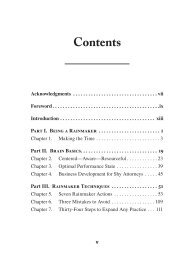(Bk Business) Carol Kinsey Goman Ph.D.-The Nonverbal Advantage_ Secrets and Science of Body Language at Work -Berrett-Koehler Publishers (2008)
Just
Just
You also want an ePaper? Increase the reach of your titles
YUMPU automatically turns print PDFs into web optimized ePapers that Google loves.
178 <strong>The</strong> <strong>Nonverbal</strong> <strong>Advantage</strong><br />
the headquarters <strong>of</strong> a nonpr<strong>of</strong>it religious organiz<strong>at</strong>ion, where<br />
they were to conduct focus groups. <strong>The</strong> staff member barely<br />
recognized her stylish boss. By dressing more like the client,<br />
Teresa fit right in. She looked like one <strong>of</strong> the nuns!<br />
<strong>The</strong> <strong>Body</strong> <strong>Language</strong> <strong>of</strong> Charisma<br />
Max Weber, the f<strong>at</strong>her <strong>of</strong> sociology, first coined the term charisma<br />
to describe inspir<strong>at</strong>ional leaders. Originally from the<br />
Greek kharisma, meaning favor or divine gift, charisma has<br />
also been defined as “part confidence, part presence, <strong>and</strong><br />
part sex appeal.” But however we define it, we know it when<br />
we see it. We call someone charism<strong>at</strong>ic when they somehow<br />
compel us to embrace their vision—whether it’s corpor<strong>at</strong>e,<br />
social, religious, or political.<br />
In the context <strong>of</strong> this chapter, I define charisma as body<br />
language th<strong>at</strong> is completely congruent with the spoken word.<br />
Whether you are in management, sales, customer service,<br />
healthcare, or educ<strong>at</strong>ion, you are the most charism<strong>at</strong>ic <strong>and</strong><br />
convincing when wh<strong>at</strong> you are feeling internally is perfectly<br />
aligned with wh<strong>at</strong> you’re expressing.<br />
I’m not the only expert to notice the connection between<br />
body language <strong>and</strong> charisma. Howard Friedman, a psychology<br />
pr<strong>of</strong>essor <strong>at</strong> the University <strong>of</strong> California <strong>at</strong> Riverside,<br />
measures charisma by studying such nonverbal cues as facial<br />
expressions, gestures, <strong>and</strong> body movements. He finds th<strong>at</strong><br />
charism<strong>at</strong>ic people smile n<strong>at</strong>urally (with wrinkling around<br />
the eyes), use a variety <strong>of</strong> gestures, <strong>and</strong> touch others during<br />
convers<strong>at</strong>ions. Friedman has developed wh<strong>at</strong> he calls the<br />
Affective Communic<strong>at</strong>ion Test, which some large U.S. corpor<strong>at</strong>ions<br />
use to measure the charisma <strong>of</strong> potential leaders.<br />
And it seems to be valid. Toyota’s top U.S. salesman scored in<br />
the ninety-fifth percentile, <strong>and</strong> the sales manager <strong>of</strong> a leading<br />
hair replacement company scored in the ninety-ninth.




